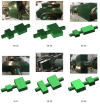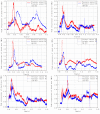Research on the Rule of Explosion Shock Wave Propagation in Multi-Stage Cavity Energy-Absorbing Structures
- PMID: 37444923
- PMCID: PMC10342288
- DOI: 10.3390/ma16134608
Research on the Rule of Explosion Shock Wave Propagation in Multi-Stage Cavity Energy-Absorbing Structures
Abstract
The propagation laws of explosion shock waves and flames in various chambers were explored through a self-built large-scale gas explosion experimental system. The propagation process of shock waves inside the cavity was explored through numerical simulation using Ansys Fluent, and an extended study was conducted on the wave attenuation effect of multiple cavities connected in a series. The findings show that the cavity's length and diameter influenced the weakening impact of shock waves and explosive flames. By creating a reverse shock wave through complicated superposition, the cavity's shock wave weakening mechanism worked. By suppressing detonation creation inside the cavity, the explosive flame was weakened by the cavity's design. The multi-stage cavity exhibited sound-weakening effects on both shock waves and explosive flames, and an expression was established for the relationship between the suppression rate of shock force and the number of cavities. Diffusion cavities 35, 55, 58, and 85 successfully suppressed explosive flames. The multi-stage cavity efficiently reduced the explosion shock wave. The flame suppression rate of the 58-35 diffusion cavity explosion was 93.38%, whereas it was 97.31% for the 58-35-55 cavity explosion. In engineering practice, employing the 58-58 cavity is advised due to the construction area, construction cost, and wave attenuation impact.
Keywords: cavity structure; explosion shock wave; explosive flame; propagation law.
Conflict of interest statement
The authors declare no conflict of interest.
Figures





















Similar articles
-
Influence of Cavity Width and Powder Filling in a Cavity on Overpressure Evolution Laws and Flame Propagation Characteristics of Methane/Air Explosion.ACS Omega. 2021 Apr 6;6(15):10072-10084. doi: 10.1021/acsomega.1c00054. eCollection 2021 Apr 20. ACS Omega. 2021. PMID: 34056162 Free PMC article.
-
Propagation laws of discontinuous gas supply in the excavation roadway.PLoS One. 2022 May 26;17(5):e0268453. doi: 10.1371/journal.pone.0268453. eCollection 2022. PLoS One. 2022. PMID: 35617247 Free PMC article.
-
Research on the influence of pits on the propagation law of explosion shock waves.Sci Rep. 2024 Jun 19;14(1):14131. doi: 10.1038/s41598-024-62603-0. Sci Rep. 2024. PMID: 38898131 Free PMC article.
-
Blast waves and how they interact with structures.J R Army Med Corps. 2001 Feb;147(1):16-26. doi: 10.1136/jramc-147-01-02. J R Army Med Corps. 2001. PMID: 11307674 Review.
-
Forensic pathological characteristics of explosion trauma in confined space terrorist mass fatalities classified with a 3-dimensional model.Leg Med (Tokyo). 2022 Sep;58:102090. doi: 10.1016/j.legalmed.2022.102090. Epub 2022 May 18. Leg Med (Tokyo). 2022. PMID: 35605313 Review.
References
-
- Wang Q., Jiang X., Deng J., Luo Z., Wang Q., Shen Z., Shu C., Peng B., Yu C. Analysis of the effectiveness of Mg(OH)2/NH4H2PO4 composite dry powder in suppressing methane explosion. Powder Technol. 2023;417:118255. doi: 10.1016/j.powtec.2023.118255. - DOI
-
- Luo Z., Su Y., Chen X., Zheng L. Effect of BC powder on hydrogen/methane/air premixed gas deflagration. Fuel. 2019;257:116095. doi: 10.1016/j.fuel.2019.116095. - DOI
Grants and funding
LinkOut - more resources
Full Text Sources

